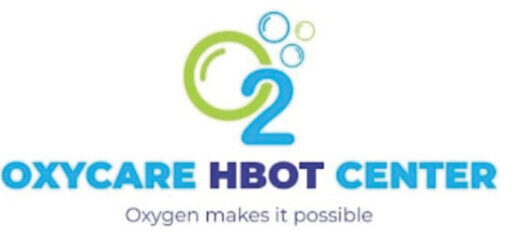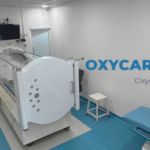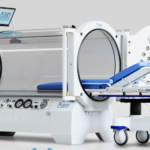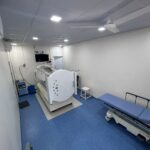Introduction
Hyperbaric Oxygen Therapy (HBOT) is a medical treatment that has gained traction in India over the past few decades. This innovative therapy involves breathing pure oxygen in a pressurized environment, allowing the body to absorb significantly more oxygen than under normal conditions. But what exactly is HBOT, and how has it developed in India?
HBOT was first used in the 1940s to treat decompression sickness in divers. However, its application in India began much later, in the 1980s, primarily for treating gas gangrene and carbon monoxide poisoning. Since then, India has seen steady growth in HBOT facilities and applications, making it an integral part of the country’s advanced medical treatments.
How HBOT Works
The Science Behind HBOT
At its core, HBOT works on a simple principle: increasing the amount of oxygen dissolved in the blood and tissues. Under normal conditions, red blood cells are almost fully saturated with oxygen. Breathing pure oxygen under increased atmospheric pressure significantly increases the amount of oxygen dissolved in the plasma, allowing it to reach areas where circulation is diminished or blocked.
This increased oxygenation can:
- Enhance the body’s ability to fight infection
- Promote the formation of new blood vessels
- Decrease swelling and inflammation
- Enhance wound healing
Types of Hyperbaric Chambers
In India, two main types of hyperbaric chambers are used:
- Monoplace chambers: These are designed for a single person and typically look like a long tube. The patient lies on a padded table that slides into the chamber.
- Multiplace chambers: These larger units can accommodate multiple patients simultaneously. Medical staff can also enter these chambers to attend to patients if necessary.
Both types are effective, and the choice often depends on the facility’s resources and the patient’s specific needs.
Medical Conditions Treated with HBOT in India
Approved Indications
In US, HBOT is approved by Insurance companies for several medical conditions, including:
- 01. Air or Gas Embolism
- 02a. Carbon Monoxide Poisoning
- 02b. Carbon Monoxide Poisoning Complicated By Cyanide Poisoning
- 03. Clostridial Myositis And Myonecrosis (Gas Gangrene)
- 04. Crush Injury, Compartment Syndrome And Other Acute Traumatic Ischemias
- 05. Decompression Sickness
- 06a. Arterial Inefficiencies: Central Retinal Artery Occlusion
- 06b. Arterial Inefficiencies: Enhancement of Healing In Selected Problem Wounds
- 07. Severe Anemia
- 08. Intracranial Abscess
- 09. Necrotizing Soft Tissue Infections
- 10. Osteomyelitis (Refractory)
- 11. Delayed Radiation Injury (Soft Tissue and Bony Necrosis)
- 12. Compromised Grafts and Flaps
- 13. Acute Thermal Burn Injury
- 14. Idiopathic Sudden Sensorineural Hearing Loss
- 15. Avascular Necrosis (Aseptic Osteonecrosis)
List of Diseases where HBOT Helps:
Indian researchers and clinicians are also exploring HBOT’s potential in treating:
- Lyme disease
- Multiple sclerosis
- Autism spectrum disorder | Cerebral palsy | Traumatic brain injury | Stroke
- Chronic fatigue syndrome | Fibromyalgia | Migraine | Complex regional pain syndrome |
- Crohn’s disease | Ulcerative colitis | Interstitial cystitis |
- Acute coronary syndrome | Cardiogenic shock |
- Chronic kidney disease | Acute kidney injury |
- Asthma | Chronic obstructive pulmonary disease (COPD) | Acute respiratory distress syndrome (ARDS) | Tuberculosis | Sleep apnea |
- Chronic venous insufficiency | Lymphedema |
- Scleroderma | Raynaud’s disease | Rheumatoid arthritis | Systemic lupus erythematosus | Polymyositis | Dermatomyositis | Vasculitis | Behcet’s disease |
- Psoriasis | Eczema | Lichen planus | Vitiligo | Alopecia areata Chronic pruritus | Pemphigus | Pemphigoid | Dermatitis herpetiformis | Sjogren’s syndrome | Rosacea | Atopic dermatitis | Contact dermatitis | Epidermolysis bullosa | Erythromelalgia |
- Neuropathic pain | Peripheral neuropathy | Diabetic neuropathy |
- Parkinson’s disease | Alzheimer’s disease | Huntington’s disease | Amyotrophic lateral sclerosis (ALS) | Muscular dystrophy | Epilepsy | Multiple system atrophy |
- Progressive supranuclear palsy | Lewy body dementia | Frontotemporal dementia | Myasthenia gravis | Guillain-Barre syndrome | Lambert-Eaton syndrome | Spinal muscular atrophy | Friedreich’s ataxia | Spinocerebellar ataxia | Charcot-Marie-Tooth disease | Bell’s palsy | Trigeminal neuralgia | Glossopharyngeal neuralgia | Postherpetic neuralgia | Occipital neuralgia | Cluster headaches | Tension headaches |
- Hepatitis | Cirrhosis | Liver failure | Non-alcoholic fatty liver disease (NAFLD) |
- | Anti Aging |
While these applications show promise, more research is needed to establish their efficacy conclusively.
The HBOT Procedure
Pre-treatment Preparations
Before undergoing HBOT, patients typically:
- 100% cotton scrubs. We will provide you daily with fresh
- No street clothes or shoes will be allowed in the chamber.
- Small children will have 100% cotton Pajama’s.
- Infants will need to be dressed in 100% cotton infant clothes.
- You will need to arrive 15 minutes early before each treatment in order to change into the fire safe 100% cotton scrubs
- No Grease or oils, such as body lotions, lipstick or hair oils, Nail polish, Hair spray, Perfumes, Makeup or hair preparations are allowed in the chamber.
- DO NOT use any petroleum base products such as Vaseline etc. prior to therapy session.
- DO NOT use alcohol for skin care.
- Deodorant without alcohol can be found at leading Health food stores.
- Please remove: Watches, wigs, and jewelry, prostheses, such as hearing aids.
- No carbonated drinks for at least four hours prior to HBOT.
- You must eat breakfast lunch and dinner, High Protein snacks if needed.
- You must check with the chamber operator before bringing anything into the chamber
- No Tape players, video games, or radios will be allowed inside the chamber.
- NO CELL PHONES OR ELECTRONICS in the chambers
- To maintain privacy and safety no visiting in the chamber room, all family members, and visitors must remain outside the treatment area.
- It is imperative to keep your appointments and receive your sessions as prescribed. This will ensure you the optimum level of results for HBOT therapy. If for any reason you cannot keep your appointment, please notify us 24 hours in advance.
- Smoking constricts your blood vessels. For maximum benefit, stop smoking during your HBOT series. If unable to quit, refrain from smoking for 2 hours or more before and after each therapy session.
- Basic Therapy Instructions; Shower, Shampoo, Dry off, eat a meal, brush your teeth, put on your scrubs, and come for treatment.
- Please provide us with all of your phone numbers, cell phones, and beepers
- All Dental work must be completed before starting HBOT, if needed we will be happy to speak with your Dentist.
- No unfinished root canals or temporary fillings or crowns, or caps.
During the Session
A typical HBOT session in India lasts between 60 to 90 minutes. During this time:
- The chamber is gradually pressurized
- Patients breathe normally, inhaling pure oxygen
- They may experience a feeling of fullness in the ears, similar to being in an airplane
Post-treatment Care
After the session:
- Patients are monitored for any side effects
- They can usually resume normal activities immediately
- A series of treatments is often prescribed, with the number depending on the condition being treated
Benefits of HBOT
The Paradox of Healing: Harnessing Hypoxia
At the heart of our groundbreaking HBOT protocol lies a remarkable paradox: the power of hypoxia. But what is hypoxia, and why should you care?
Hypoxia is a controlled reduction in oxygen levels – a carefully regulated state where your body experiences a fast decline in high oxygen levels down to normal levels. This may sound counterintuitive, but it’s precisely this temporary dip in oxygen that triggers your body’s natural repair mechanisms, setting in motion a cascade of regenerative responses.
The Hyperoxic-Hypoxic Paradox: Revving Up Your Biochemistry
When your body reacts to this hypoxic state, it activates a robust process called the “hyperoxic–hypoxic paradox,” or HHP. This biochemical phenomenon unleashes a remarkable transformation within your cells, elevating your body’s regenerative capacity in four remarkable ways:
- Increased Mitochondrial Volume: HHP dramatically boosts the volume of mitochondria, the powerhouses within your cells that convert oxygen into energy.
- Enhanced Mitochondrial Efficiency: HHP makes your mitochondria more efficient at converting oxygen into the energy your body needs.
- New Blood Vessel Formation: HHP stimulates the generation of new blood vessels in areas with reduced blood flow, improving circulation and nutrient delivery.
- Accelerated Stem Cell Production: HHP accelerates the production and migration of stem cells, your body’s natural healers, to areas needing repair.
Shifting from Degeneration to Regeneration
Ultimately, this hypoxic-induced HHP is the key to unlocking your body’s power to heal itself from within. By strategically leveraging this biochemical paradox, our HBOT protocol can shift your body from degeneration to regeneration, setting the stage for remarkable healing and recovery.
HBOT: The Gateway to Holistic Healing
HBOT isn’t just another therapy – it’s the gateway to unleashing your body’s innate healing potential. By harnessing the power of hypoxia and the hyperoxic-hypoxic paradox, our HBOT protocol taps into the very core of your body’s regenerative processes, empowering you to overcome a wide range of health challenges, from PTSD to neurological conditions and beyond.
Imagine what this could mean for you or a loved one struggling with the debilitating effects of trauma, injury, or chronic illness. The key to unlocking your body’s healing power lies in the paradox of hypoxia, and HBOT is the tool that can help you harness it.
Potential Risks and Side Effects
Common Side Effects
While HBOT is generally safe, some patients may experience:
- Temporary nearsightedness
- Middle ear injuries
- Sinus discomfort
- Claustrophobia (particularly in monoplace chambers)
Rare Complications
In rare cases, more severe complications can occur:
- Oxygen toxicity, leading to seizures
- Collapsed lung (pneumothorax)
- Air embolism
These risks underscore the importance of administering HBOT by trained professionals in certified facilities.
Cost of HBOT in India
Pricing Factors
The cost of HBOT in India can vary based on:
- The type of facility (government vs. private)
- The condition being treated
- The number of sessions required
- The city where treatment is sought
Comparison with International Rates
Generally, HBOT in India is significantly more affordable than in many Western countries. A single session might cost between ₹5,000 to ₹15,000 (approximately $60 to $180), compared to $200 to $400 in the United States. This cost-effectiveness has contributed to India’s growing medical tourism industry.
HBOT Research in India
Current Studies
Indian researchers are actively contributing to the global body of HBOT knowledge. Current areas of focus include:
- HBOT’s role in managing diabetic foot ulcers
- Its potential to treat neurological conditions
- Combining HBOT with stem cell therapy
Future Directions
Emerging research directions in India include:
- Personalized HBOT protocols based on genetic factors
- Development of portable HBOT devices for home use
- HBOT’s potential in anti-aging treatments
Patient Experiences
Success Stories
Many patients in India have reported significant improvements after HBOT:
- Faster healing of chronic wounds
- Improved quality of life for those with radiation injuries
- Enhanced recovery from certain neurological conditions
Challenges Faced
However, some patients have faced challenges:
- Limited availability of HBOT centers in smaller cities
- High out-of-pocket costs, as many insurance plans don’t cover HBOT
- The need for multiple sessions, which can be time-consuming
HBOT and Traditional Medicine
Integration with Ayurveda
Some Indian practitioners are exploring ways to integrate HBOT with Ayurvedic treatments:
- Using HBOT alongside herbal remedies for wound healing
- Combining HBOT with Panchakarma therapies for detoxification
Complementary Therapies
HBOT is often used in conjunction with other treatments:
- Physical therapy for neurological conditions
- Nutritional support for enhanced healing
- Stress reduction techniques to maximize therapy benefits
Training and Certification for HBOT Practitioners
Educational Programs
Several Indian institutions now offer specialized training in HBOT:
- Short-term courses for doctors and nurses
- Incorporation of HBOT in certain postgraduate medical curricula
Professional Organizations
The Undersea and Hyperbaric Medical Society (UHMS) has an Indian chapter that:
- Promotes education and research in HBOT
- Organizes conferences and workshops
- Advocates for standardization of HBOT practices in India
HBOT Tourism in India
Medical Tourism Trends
India’s reputation for high-quality, affordable healthcare has extended to HBOT:
- Growing number of international patients seeking HBOT in India
- Combination of treatment with cultural experiences
Packages and Services
Many hospitals offer comprehensive packages for international patients:
- Treatment plans including HBOT sessions
- Accommodation arrangements
- Travel assistance within India
Future of HBOT in India
Technological Advancements
The future of HBOT in India looks promising with:
- Development of more comfortable and efficient hyperbaric chambers
- Integration of telemedicine for remote monitoring of HBOT patients
- Exploration of hyperbaric oxygen administration at home for certain conditions
Expanding Applications
Researchers and clinicians in India are exploring HBOT’s potential in:
- Sports medicine for faster recovery from injuries
- Cosmetic applications for skin rejuvenation
- Management of long-term effects of COVID-19
Conclusion
Hyperbaric Oxygen Therapy in India has come a long way since its introduction in the 1980s. Today, it stands as a testament to the country’s growing medical capabilities, offering hope to patients with various conditions. As research progresses and technology advances, HBOT will likely play an increasingly important role in India’s healthcare landscape.
While challenges remain, particularly in terms of accessibility and cost, HBOT’s future in India looks bright. With continued research, technological innovations, and integration with traditional healing systems, HBOT can potentially improve the lives of countless patients in India and beyond.
FAQs
- Is HBOT safe for everyone? While generally safe, HBOT is not suitable for people with certain conditions like untreated pneumothorax or some types of lung disease. Always consult with a qualified physician before undergoing HBOT.
- How many HBOT sessions are typically needed? The number of sessions varies depending on the condition being treated. Some acute conditions might require only a few sessions, while chronic conditions might need 20-40 sessions or more.
- Is HBOT painful? HBOT is not painful, but some people may experience discomfort due to pressure changes, similar to what you might feel in an airplane.
- Can I eat before an HBOT session? It’s generally recommended to have a light meal before treatment. Your healthcare provider will give you specific instructions.
- Are HBOT results permanent? The durability of results depends on the condition being treated. For some conditions, the effects can be long-lasting, while others may require periodic maintenance treatments.








Leave a Reply